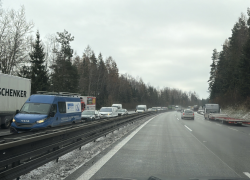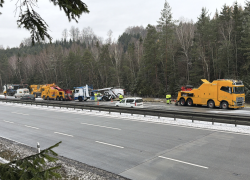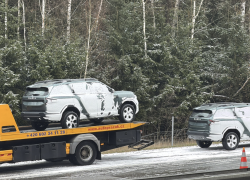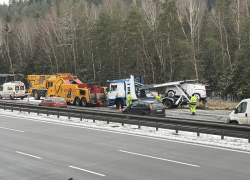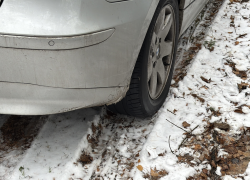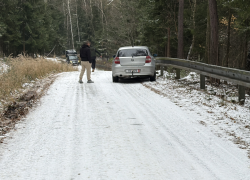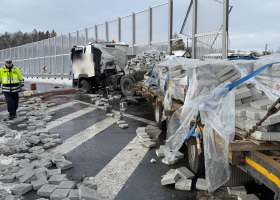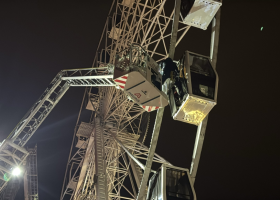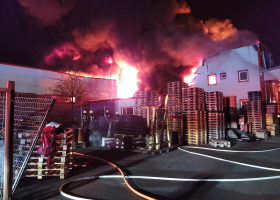-
Traffic collapse in the Czech Republic after 3 cm of snow. Desperate drivers on summer tires then try to go down hills and often get stuck.
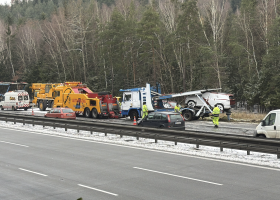
© AKTU.cz, Jiří Forman The Czech Republic has been paralyzed in recent days by a severe snow calamity that caused an utter collapse of traffic on a number of key road routes and in cities. The most critical situation was on the D1 motorway, where traffic jams tens of kilometers long formed in both directions. Drivers who were still using summer tires and tried to bypass the traffic problems via surrounding roads, often not covered by winter maintenance, played a decisive role in the chaos. In doing so they blocked the only available access routes and further worsened the situation.
Traffic collapse on the D1 motorway
From the early morning hours, multi-kilometre tailbacks formed on the D1 from Vysočina towards Prague, caused not only by heavy snowfall and icy conditions but mainly by a series of traffic accidents, including collisions between trucks and passenger cars. The situation was made critical by the fact that large trucks could not climb hills because of the slippery surface, often blocking traffic and even the emergency corridor. On the first ten kilometres of the D1 alone, according to the Road and Motorway Directorate, eight out of ten gritters ended up stuck in the queues, which made effective winter maintenance impossible. Delays reached up to two hours.
Traffic accidents, injuries and emergency services' responses
Firefighters and police had their hands full across the country. Just during the night and morning they had to respond to sixty traffic accidents, which is a typical average for an entire day. On the D1 there were collisions involving trucks and vans; fortunately most of these did not result in serious injuries, but traffic was repeatedly completely closed or severely restricted.
Problems in regions and cities
The traffic collapse affected not only the motorway network but also regional roads and public transport. Public transport was significantly limited in places; some bus services were cancelled while others suffered major delays. Railways reported similar problems, with some trains running up to two hours late.
Prague region
In Prague and the surrounding areas, traffic was complicated especially in hilly sections, where many vehicles stalled and caused jams, particularly on the outskirts and on the approaches to the city. Public transport experienced noticeable delays; in some places staff had to clear vehicles that could not continue.Central Bohemian region
The area around the metropolis was hit by traffic jams mainly on the main routes towards South and East Bohemia. Diversions ran along poorly maintained sections that drivers with summer tires either completely blocked or ended up in ditches on.
Vysočina
Vysočina was traditionally among the hardest-hit regions. Despite strong winds and heavy snowfall, hundreds of cars and trucks repeatedly became stuck, especially on steep climbs. Road maintenance crews had limited options for gritting and ploughing, though they worked continuously. In some places traffic was paralysed for several hours.
South Moravian region
South of Brno the situation was also overwhelmed by undisciplined drivers trying to bypass the D1 through nearby villages, where local roads had not been chemically treated. Many of them became stranded on slippery roads, which significantly complicated passage for firefighters and emergency crews as well.
Moravian-Silesian and Olomouc regions
In northern and north-eastern Moravia and in Silesia, the snowfall had similarly dramatic consequences. Drivers on summer tires and the lack of preparedness of some roads played a role, creating long queues not only on main routes but also on smaller roads around larger towns.
Pilsen and Karlovy Vary regions
Western Bohemia was hit hard by snow. In the west of the country some sections were completely closed, frequent accidents occurred and heavy equipment was deployed even on diversion routes.
Liberec and Hradec Králové regions
Mountain areas faced extreme conditions, where the situation was often unbearable due to snowdrifts and ice. Local roads were frequently impassable for many hours.
Problem with summer tires and detours
One of the main factors behind the chaos on the roads was the portion of drivers who disregarded rules and risked driving on snow and ice with summer tires. Some also tried to avoid main queues via unsecured side roads, thereby blocking emergency services and completely preventing passage even where there was still a chance to make the road passable. These situations again showed the need for stricter checks on the use of winter equipment and for raising awareness about the risks of driving in winter conditions.
Meteorological situation and outlook
Meteorologists say the weather will continue to complicate transport in the coming days – further snowfall and local icy conditions are expected, which could paralyse traffic in additional regions. Night temperatures fell as low as minus seven degrees, which reduced the effectiveness of gritting, and some sections of road were almost impassable.
Advice to drivers
The police and road maintenance crews repeatedly urge drivers to adapt their speed and driving style to the current conditions, to maintain an emergency corridor and to follow current traffic news[1][11][4]. Public transport passengers should expect significant delays.
The traffic collapse after the sudden onset of winter weather once again showed how sensitive the Czech transport system is to extreme natural conditions and how difficult it can be to keep key routes passable during heavy snowfall and icy conditions


